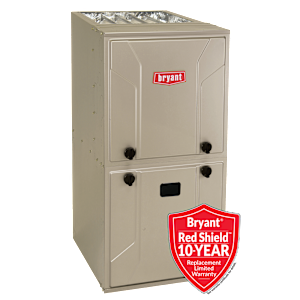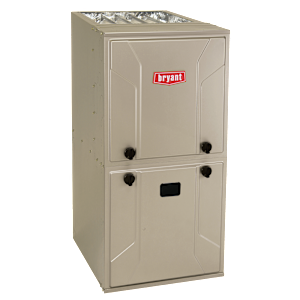About The Author: Travis Baugh is a Digital Brand Marketing Manager for Bryant, where he creates clear, helpful content to guide homeowners through heating, cooling, and indoor air quality decisions. His goal is to empower readers with the knowledge they need to choose the right comfort solutions for their home—confidently and comfortably.
What is a Furnace?
A furnace is a vital heating appliance used in homes across North America. It operates by converting fuel into heat, which is then distributed throughout the living space via ductwork. Furnaces can be powered by natural gas, oil, electricity, or propane, depending on availability and homeowner preference. In this guide, we’ll walk through what is a furnace, how does a furnace work, different types of furnaces, and choosing a furnace.
What Is A Furnace?
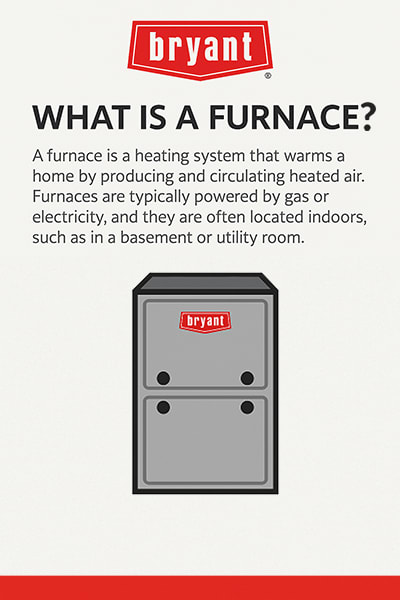
A furnace is a heating system that warms air and distributes it throughout a home to maintain a comfortable indoor temperature. It works by burning fuel (such as a natural gas furnace, oil, or propane furnace) or using electricity to heat air, which is then blown through ducts and vents by a blower fan
How Does A Furnace Work?
Andrew Mackey, owner of Superior Service in Lake St Louis, Missouri, breaks down how a gas furnace works in as simple terms as possible.
“The furnace works by heating metal tubing located in furnace to a hot temperature,” Andrew Mackey said. “Then when that metal gets to a certain temperature, the blower motor that circulates air throughout the home turns on. The air is then blown through the home until the thermostat reaches the desired set temperature. The furnace then will shut down until the thermostat signals a call for heat again.”
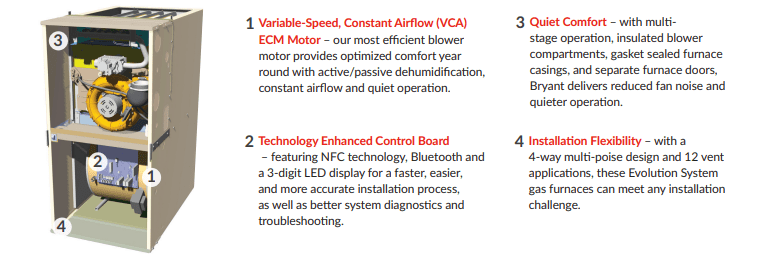
Types of Furnaces
When it comes to heating your home, there are several types of furnaces to choose from, each with its own advantages and considerations. Let's explore the three main types of furnaces: gas, electric, and oil.
Gas Furnaces
Gas furnaces are one of the most common types found in homes. They use natural gas as a fuel source to generate heat and are known for their efficiency and cost-effectiveness. Gas furnaces provide reliable and consistent warmth throughout your home, even during the coldest winter months.
Electric Furnaces
Electric furnaces use electricity to generate heat. While they may not be as energy-efficient as gas furnaces, they offer their own set of benefits. Electric furnaces are typically more affordable to install and have lower maintenance costs. They are also safer, as they don't produce any combustion byproducts or require a fuel source. Understand gas vs electric furnaces.
Oil Furnaces
Oil furnaces burn heating oil to produce heat. They are known for their durability and longevity. While oil furnaces require regular maintenance and have higher upfront costs, they can be an excellent choice for homeowners with access to oil who want a reliable heating system.
When considering what does a furnace look like, all these types have a similar external appearance, typically featuring a metal cabinet that houses the various internal components. Learn more in our guide on types of furnaces.
Benefits of Furnaces
Furnaces offer numerous benefits, making them a popular choice for heating homes. From efficient heating to consistent heat distribution and cost-saving features, modern furnaces provide homeowners with a reliable and comfortable heating solution. Let's dive into the benefits of a furnace:
- Efficiency: One of the key advantages of furnaces is their efficient heating capability. Furnaces are designed to convert fuel or electricity into heat, ensuring that your home stays warm during the colder months. With advanced technologies like variable-speed blowers, modern furnaces are highly efficient, minimizing energy waste and reducing heating bills.
- Reliable and Consistent Heat: Furnaces provide steady, reliable heat even in very cold weather, ensuring your home stays warm and comfortable throughout the winter months.
- Even Heat Distribution: Another benefit of furnaces is their ability to provide consistent and even heat distribution throughout your home. Unlike other heating systems, furnaces distribute warm air through ductwork, ensuring that every room receives adequate heating. This eliminates cold spots and creates a comfortable living environment in every corner of your house.
Furnace Maintenance
Regular furnace maintenance is essential to ensure optimal performance and extend the lifespan of your heating system. By maintaining your furnace regularly, you can prevent potential problems and ensure your home stays warm and comfortable throughout the colder months. Learn more about furnace maintenance.
“Homeowners need to schedule yearly maintenance to check out the entire HVAC system to prevent breakdowns and ensure that the furnace will last its full life expectancy,” Mackey said.
Common Furnace Problems and Solutions
Despite regular maintenance, furnaces can sometimes encounter problems. Some common furnace problems include a malfunctioning thermostat, ignition issues, strange noises, or uneven heating. If you experience any of these issues, it is important to perform furnace troubleshooting and address the issues promptly.
For a malfunctioning thermostat, check the batteries and ensure it is set to the desired temperature. If the problem persists, consult the furnace's user manual or contact your local Bryant dealer for assistance.
Ignition problems can occur due to a faulty pilot light or electronic ignition system. In such cases, it is best to leave the troubleshooting to your local Bryant dealer.
There are several other signs that indicate a need for professional furnace service. If your furnace fails to produce heat, emits a strong odor, or constantly cycles on and off, it is advisable to seek professional help.
Other warning signs include increased heating bills, inconsistent temperatures throughout your home, or excessive dust accumulation. These issues could be indicative of more significant problems that require expert attention.
"For gas furnace troubleshooting, we recommend checking that your thermostat is set to heat mode, the furnace has power (breaker, shut-off switch, fan test), the furnace filter is clean, and all vents are open and unobstructed,” Melissa Frause, owner of Bob’s Heating and Air Conditioning in Woodinville, WA, said. "If all of these have been checked, then it’s time to call your local service professional."
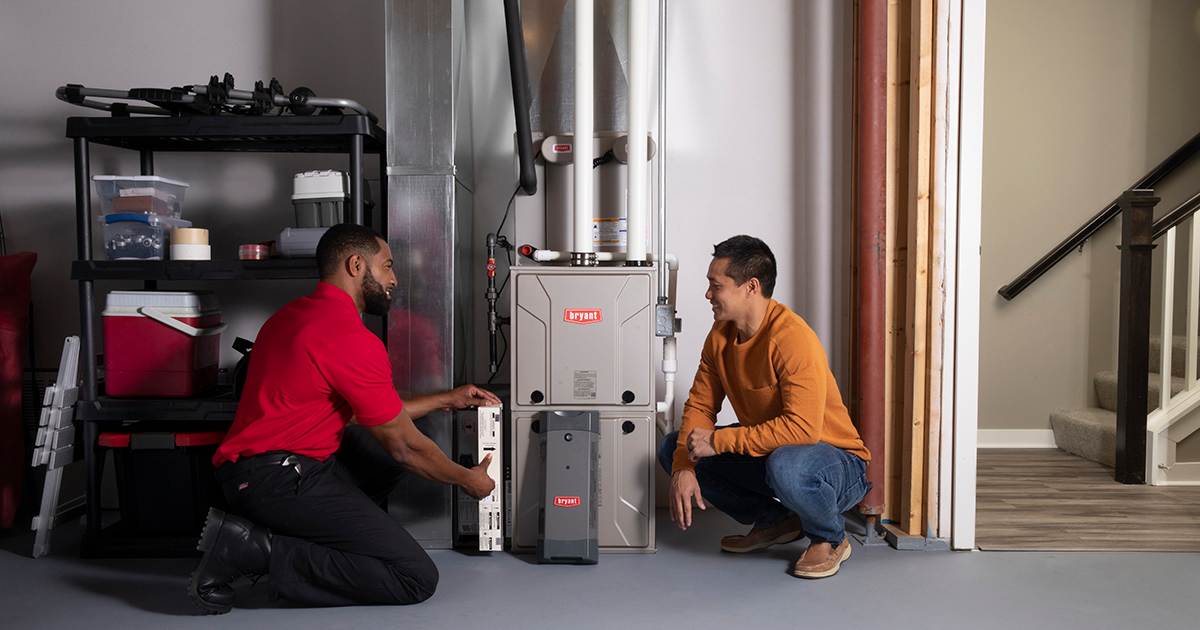
Connect With A Bryant Dealer For a Bryant Furnace
At Bryant, we offer a range of high efficiency furnaces designed to meet your heating needs. Our furnaces are built with advanced technology to provide optimal performance, energy efficiency, and comfort. Upgrading to a Bryant furnace ensures that your home stays warm and comfortable while helping you save on energy costs.
Whether you're looking for furnace replacement or furnace repair, Connect with your local Bryant dealer to explore the benefits of a Bryant furnace for your home. Their knowledgeable team can help you select the perfect furnace based on your heating needs, ensuring optimal efficiency, comfort, and reliability.
Explore Bryant Furnaces
Choose a Bryant furnace for reliable, efficient heating that keeps your home comfortable throughout the winter. Known for their durability and advanced technology, Bryant furnaces offer quiet operation, precise temperature control, and energy-saving features like variable-speed motors and 2-stage heating. With a range of models to suit different home sizes and needs, Bryant furnaces are built to last and come with industry-leading warranties, providing peace of mind and long-term value for your home heating system.
What Is A Furnace FAQs
A furnace is a heating system that warms your home by generating heat—typically using gas or electricity—and distributing it through ductwork and vents.
No, a furnace provides heat, while an AC provides cooling—though they often share the same air handler, blower, and ductwork in a central HVAC system.
A furnace is a type of heater, but not all heaters are furnaces; furnaces use forced air, while other heaters may use electric elements, radiant heat, or boilers.
Furnaces can be powered by natural gas, propane, or electricity, with gas models being more common in colder climates due to their stronger heat output.
While the furnace doesn't cool your home, its blower motor helps circulate air for both heating and cooling, making it an essential part of your central AC system.
A two-stage furnace has two levels of heating output: a low stage for mild temperatures and a high stage for colder weather. This allows the furnace to operate more efficiently by adjusting its heat output based on the home's needs, providing consistent comfort and improved energy efficiency.
A modulating furnace adjusts its heating output in small increments, based on the home’s temperature needs. Unlike single-stage or two-stage furnaces, it operates at varying levels, providing more precise temperature control, increased efficiency, and consistent comfort by continuously adjusting the heat to the ideal level.
Yes. Even gas furnaces need electricity to power components like the blower motor, igniter, and control board.
Furnaces can run on natural gas, propane, oil, or electricity, depending on the model and local fuel availability.
A furnace is typically a rectangular metal cabinet connected to ductwork, containing burners, a blower, and controls for heating and air distribution.
Learn More About Furnaces
- Learn how much is a new furnace
- Discover what is a heat pump vs furnace
- Learn the importance of the AFUE furnace rating
- Find out how long does a furnace last
- Discover the differences between a furnace vs boiler
- Explore down flow furnaces


